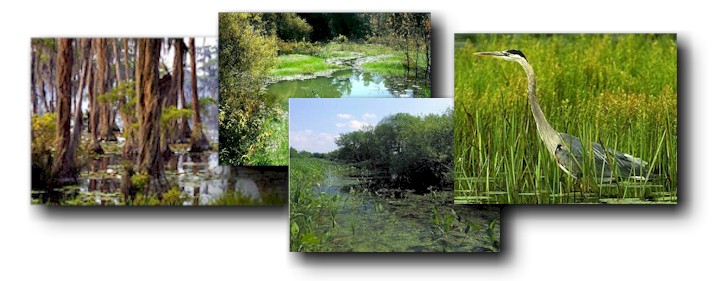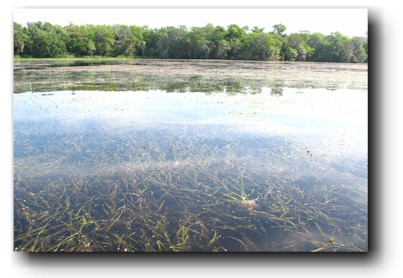|
|
|||
|
|||
|
* Select A Small Upstream Section Of A Tributary For Restoration * Introduce NEW Natural Pollution Filtration Systems * Introduce NEW Proprietary Pollution Filtration Technologies * Remove Contaminated Sediment From Wetlands & Stream Bottom * Restore The Stream Wetlands And Aquatic Vegetation * Restore The Submerged Aquatic Vegetation (SAV) * Restore The Fish, Wildlife & Upland Vegetative Communities
Despite thirty years of clean-up efforts since the passage of The Clean Water Act in 1972, the St Johns River and its tributaries remain contaminated and continue in a state of decline. Therefore we should begin a new course of action, embracing a more aggressive approach to restore the river.
A "watershed" or "tributary" focus and clean-up approach should be adopted.
The following sources of pollution need to be more closely addressed:
* Stormwater runoff continues to be a major source of pollution. Stormwater ponds, designed to capture pollutants, have been installed by the thousands yet are rarely if ever cleaned. Contaminants collect in the ponds and wash into the river during heavy rain events.
* Stormwater runoff from construction sites continue as a large contributing source of pollution.
* Silt and contaminated sediment blankets the bottom of the river. In many places water depth is greatly reduced as the river has literally been filled in with muck. These poisons create an underwater desert devoid of life.
* Raw sewage frequently enters the river via leaking septic tanks, broken sewer lines and malfunctioning lift stations.
* Wastewater treatment plants continue to release large amounts of nutrients and other contaminants.
The following action items should be initiated:
By focusing on a small section of the river, restoration results can easily be observed and measured. This will serve as a pilot project where we install/implement and refine the chosen restoration technologies and procedures. Further refinements will serve as a template for a restoration program for the entire St Johns River watershed.
Natural Pollution Filtration Systems The original wetlands along the St Johns consisted of an extensive tree canopy as well as plentiful shrubs plants and grasses. These wetlands began to disappear as waterfront homes and businesses were built in the river basin. These natural filtration systems (which act like our kidneys) in removing pollutants and impurities are vital to the health of the river. A concerted effort to reestablish an extensive tree canopy, shrubs and grasses and other natural systems will be a major component in the restoration plan.
Proprietary Pollution Filtration Technologies There are numerous leading edge proprietary pollution filtration technologies that will be an integral part of the restoration effort. Included in this restoration plan are a few examples of these products, known in scientific circles as Structural BMPs (Best Management Practices). The majority of these products are designed to filter and capture pollutants in stormwater runoff. Software that is designed to develop restoration strategies, track and quantify the removal of individual pollutants will be employed as well.
Contaminated Sediment Removal The St Johns and its tributaries suffer with a vast layer of contaminated sediment that coats the bottom of these rivers. This toxic mixture of silt, sand and muck contains numerous poisons that continue to kill the river’s aquatic ecosystem. This layer of “sludge” has accumulated after many years of stormwater runoff washing in the dirt, chemicals, oil, trash and debris from the roofs, roads and parking lots. Industrial pollutants and inefficient and malfunctioning wastewater treatment plants also add to the contaminants that damage the river. The restoration of the rivers will require that this contaminated sediment be REMOVED.
Submerged Aquatic Vegetation (SAV) Native SAV and floating aquatic vegetation will be reestablished as a vital part of the river restoration. These original aquatic plant communities are critical to the health of the river ecosystems as they capture and uptake the Nitrogen and Phosphorus that enters the river. When this aquatic vegetation is not present to act as a filter, algae blooms result.
Ecological Restoration The restoration plan will include upland and wetland ecological studies, wildlife assessments, endangered and threatened species permitting and relocation, wetland delineation, wetland permitting, wetland mitigation design, upland and wetland habitat enhancement.
The Cedar River is an impaired urban tributary that flows into the Ortega River in Jacksonville's Riverside and Ortega neighborhoods and would be a candidate for the envisioned River Restoration Plan. The Cedar River suffered a rapid environmental decline beginning in the mid 1960s as Jacksonville's population and industry grew along its shores and upper reaches. Upstream, numerous industrial based companies built facilities which directly contributed to the river's degradation. The surrounding neighborhoods developed, adding tremendous amounts of impervious surface area. Wastewater treatment plants were added and soon fell into disrepair this adding severe pollutant loads to the watershed. Stormwater pipes added massive amounts of contaminant sediment and biological debris loadings as well.
|
|||
Restore The Rivers * 3088 Country Club Blvd. * Orange Park, FL 32073 Phone 904-327-1202 *
Info@restoretherivers.com * www.restoretherivers.com
Copyright © 2009 Restore The Rivers All Rights Reserved
|


 The
The 